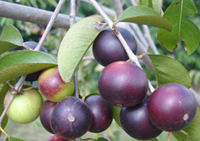

Study identified the best harvest period and ideal storage temperature for increasing the feasibility of consumption of the Amazon fruits camu-camu, bacupari and abiu
Study identified the best harvest period and ideal storage temperature for increasing the feasibility of consumption of the Amazon fruits camu-camu, bacupari and abiu.
Study identified the best harvest period and ideal storage temperature for increasing the feasibility of consumption of the Amazon fruits camu-camu, bacupari and abiu.

Study identified the best harvest period and ideal storage temperature for increasing the feasibility of consumption of the Amazon fruits camu-camu, bacupari and abiu
By Karina Toledo
Agência FAPESP – The functional properties of the majority of Amazon fruits have already been characterized in several studies. However, consumers from other regions of the country and the world generally have access to these foods only after they are processed, generally in the form of frozen pulp or sweets.
To make it easier to sell three native species – camu-camu (Myrciaria dubia), bacupari (Garcinia gardneriana) and abiu (Pouteria caimito) – fresh inside and outside the country, researchers from the Universidade de São Paulo (USP) investigated the ideal harvest period and storage temperature to allow the extension of the maximum shelf life after harvesting.
“The camu-camu was chosen as the flagship fruit for the work because it is a species known for its high vitamin C content. The ascorbic acid level of this fruit can be up to 150 times higher than that of an orange. Additionally, it is rich in anthocyanin, a pigment with antioxidant properties,” commented Patrícia Maria Pinto, a researcher from the Post-Graduate Program in Phytotechnics at the Luiz de Queiroz Agricultural School at the Universidade de São Paulo (Esalq-USP).
According to Pinto, who is a FAPESP fellow for her Master’s and Doctoral theses, bacupari was chosen because it is rich in carotenoids and has active ingredients with bactericidal properties. The flavorful abiu is rich in vitamins A, B and C in addition to calcium and phosphorus.
“They are underexplored fruit that have been commercialized only on a small scale in the country and even have export potential,” commented Pinto.
The research project was conducted in the Post-Harvest Fruit and Vegetable Laboratory under the direction of Professor Angelo Pedro Jacomino of Esalq’s Department of Vegetable Production. Part of the analysis was conducted at the University of Florida under the supervision of professor Steven Sargent.
The fruit were picked in different stages of maturity. The ideal period for each species was determined through physical, chemical and physiological analyses and quality tests.
“Some fruit, such as bananas, can be picked still green. These are called climacteric fruit. Others, such as pineapple and orange, need to be totally ripe because the ripening process is interrupted by the harvest. If they are picked too early, the quality of the fruit is jeopardized. These are the so-called non-climacteric fruit,” explained Pinto.
According to the results of the analysis, the camu-camu and the abiu can be picked 15 days before complete ripening. “The ideal point for camu-camu is when its peel is reddish-green. For the abiu, reddish-yellow is ideal,” commented Pinto.
The bacupari, on the other hand, has proven to be a non-climacteric fruit. It must be picked completely ripe, when the peel develops an orange color.
The fruit were subsequently subjected to different storage temperatures. The Esalq researchers found that abiu and bacupari could be refrigerated at 10ºC for more than 15 days without changes in color or damage to the fruit due to the cold. Camu-camu can be stored at 5ºC, also for more than 15 days, without any impact. At room temperature, the shelf life after harvesting the fruit was approximately one week.
“We evaluated the coloring of the fruit, the firmness, the degree of acidity and soluble solids and the integrity of pigments and vitamins to determine how long they will remain feasible for consumption,” explained Pinto.
Other fruit
Although they are native species to the Amazon, the fruit used in the research were grown in São Paulo State. The abius were from commercial orchards in the Mirandópolis region. The bacuparis and the camu-camus were from the Tropical Fruit Collection at the Bebedouro Experimental Station of the Citriculture Experimental Station, a partner institution in the development of the study.
“We wanted to show the producers that with the correct techniques, these Amazon forest species will develop well in other regions and have a good shelf life after collection,” explained Pinto.
According to her, these analyses performed in the study could serve as the basis for studies of other fruit, including açaí, the superstar of fruit growing in the Amazon.
“There are few studies on the post-harvest shelf life of fresh acai. The majority of these studies have been conducted with industrialized products in the form of juice, frozen pulp or powder. It would also be interesting to intensify the studies with other Amazon species, such as cupuaçu and guaraná,” she added.
Republish
The Agency FAPESP licenses news via Creative Commons (CC-BY-NC-ND) so that they can be republished free of charge and in a simple way by other digital or printed vehicles. Agência FAPESP must be credited as the source of the content being republished and the name of the reporter (if any) must be attributed. Using the HMTL button below allows compliance with these rules, detailed in Digital Republishing Policy FAPESP.





